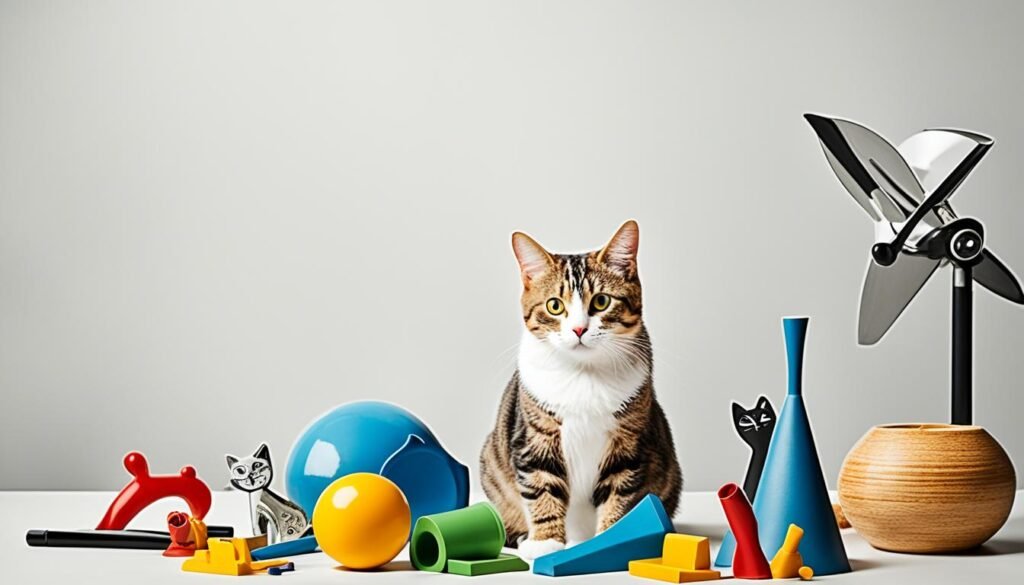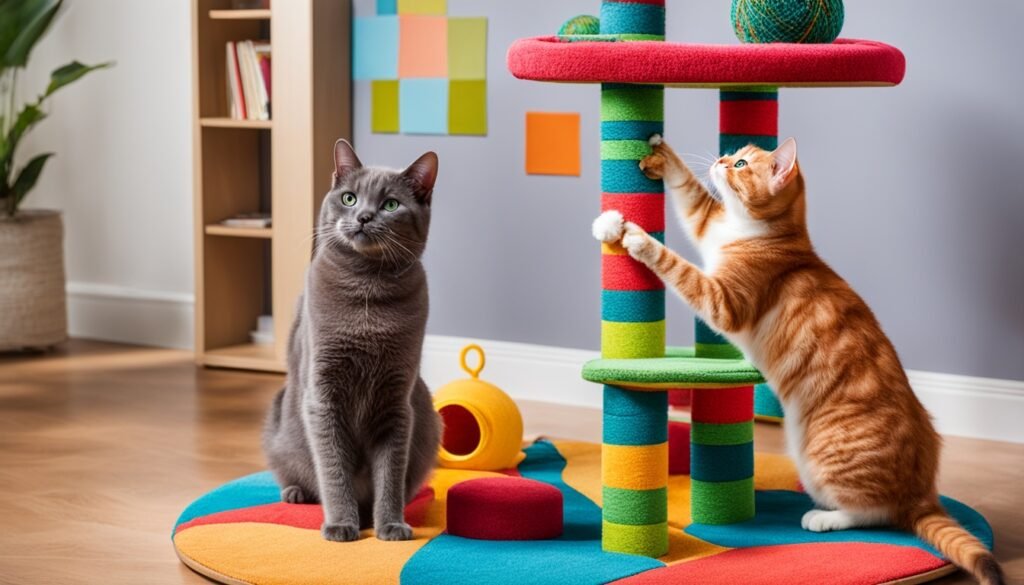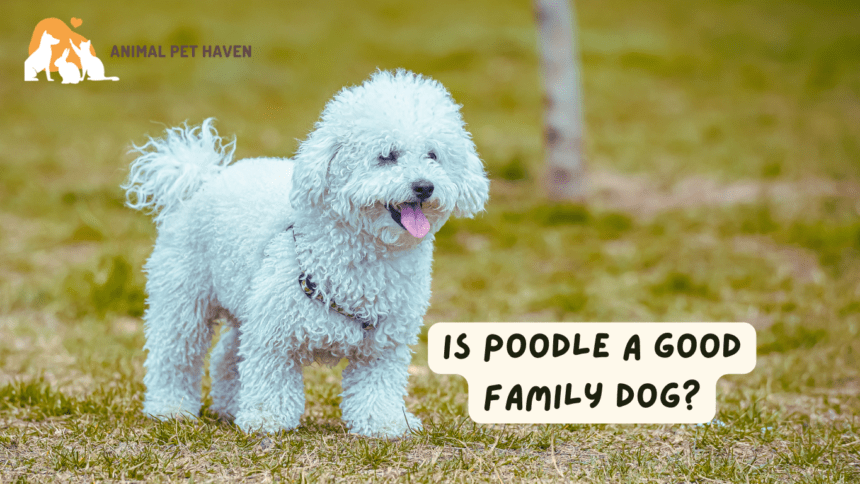The picture of a cat enjoying the sun on a windowsill seems peaceful. Yet, it hides a key part of their health— Indoor cat playtime needs to play to keep healthy, avoid boredom, and not get fat. Many cat owners wonder not only about the importance of play but also how much is enough. It’s a big deal because many pets in the U.S. are getting too heavy.
Experts say indoor cats should have three play sessions a day, each five minutes long. These playtimes should include actions like climbing, jumping, and chasing. These activities help them stay in shape and stop them from scratching up your home. A perfect play area would have a tall cat tree with different materials like sisal for climbing and scratching.
About 60 percent of cats in the U.S. are too heavy or fat. So, playtime every day is key. To keep cats interested, try using different toys like toy mice, feather sticks, or laser pointers. Cat expert Pam Johnson-Bennett suggests 15 minutes of play once or twice a day can really improve a cat’s life. Playing with your cat the right way helps them act on their instincts and strengthens your bond.
Understanding Your Indoor Cat’s Physical and Mental Exercise Needs
Indoor cats need plenty of exercise and play. This keeps them healthy and stops behavior problems. Without enough play, they could get fat, diabetes, and high blood pressure.
Why Exercise and Play Are Crucial for Indoor Cats
Play helps indoor cats stay in shape and feel good. Doing activities every day builds strong muscles. It also stops health problems like obesity and diabetes. Interactive play keeps their minds active. This stops stress-related actions.
The Balancing Act: Physical Health and Behavioral Habits
A mix of exercise and fun activities is important. It keeps blood pressure normal and helps with weight control. Playing with toys like feathers or wands is great. It gives physical and mental exercise.
Having short play sessions throughout the day is good. It fits a cat’s natural behavior. This keeps them healthy and happy. It also makes the bond between you and your cat stronger.
| Cat Category | Recommended Daily Playtime | Types of Suggested Activities |
|---|---|---|
| High Energy Breeds (e.g., Bengals, Abyssinians) | 30-45 minutes | Interactive toys, Controlled outdoor access, Puzzle toys |
| Kittens | 40-60 minutes | Feather teasers, Wand Toys, Multi-dimensional play spaces |
| Adult Indoor Cats | 20-30 minutes | Puzzle feeders, Climbing structures, Safe outdoor enclosures |
| Older or Less Active Breeds (e.g., Persians, Ragdolls) | 15-20 minutes | Gentle play with soft toys, Short walks in a cat-fenced garden |
Customizing playtime for your indoor cat is key. It ensures a good balance of body and mind health. Play is a way to keep them from getting sick.
The Daily Routine: How Much Playtime Do Indoor Cats Need
Knowing about a cat’s daily routine and adding enough playtime are key for their health and joy. Indoor cats need planned playtime to meet their exercise needs. This helps stop health problems like obesity and diabetes. It’s best to have a few intense play periods daily to manage their energy.
Indoor cats should play actively for 10-15 minutes a few times every day. These short, energetic playtimes copy their natural behaviors, helping their body and mind. Meeting these needs can greatly lower the chances of issues from boredom and too much energy.
Tailoring playtime to fit a cat’s playtime needs is essential. The type and amount of play vary with a cat’s age, breed, and personality. Active breeds like the Abyssinian may need more play than calmer breeds like the Persian. This way, every cat gets the right amount of fun and exercise.
| Age Group | Suggested Daily Playtime |
|---|---|
| Kittens | 40-60 minutes |
| Adult Cats | 30-50 minutes |
| Senior Cats | 20-30 minutes |
Using different toys and play methods makes playtime better for indoor cats. It’s not only fun but also builds a loving bond between cats and their owners. Plus, it lowers stress for both.
To fully meet cat’s playtime needs and exercise needs, have a regular daily schedule. Include time for playing together and alone. This keeps your indoor cat happy, healthy, and entertained.
Let Your Cat Pounce: The Nature of Cat Playtime
It’s key to understand your cat’s natural animal instincts. They need to pounce, hunt, and explore because of these instincts. This behavior is fun for them and good for their health.
Having plenty of play and activity is a must for cats of all ages. It’s like they’re living in the wild. Playtime that mimics this can make your cat happier and healthier. When cats play, they get a surge of energy. This keeps them fit and their minds sharp.
- Bursts of Energy: Short, intense play matches the energy they’d have while hunting in the wild.
- Pounce and Chase: Toys that move in surprising ways are great. They act like real prey and make cats happy.
- Climbing and Exploring: Cat trees and perches are perfect. They let cats climb and watch over their area safely.
The playtime a cat needs depends on their age, breed, and health. Kittens and active breeds like Bengals need more play. Older cats do better with less.
| Age/Condition | Daily Playtime Duration | Session Characteristics |
|---|---|---|
| Kittens/Young cats | 30-60 minutes | Frequent, intense sessions |
| Adult Cats | 20-40 minutes | Moderate, interactive sessions |
| Senior Cats | 10-20 minutes | Gentle, short sessions |
Playing with your cat with wand toys and feather teasers is fun. It makes your bond stronger and keeps them fit. It also lowers their chance of getting fat and having health problems.
Watch how your cat acts during play, especially if they have health problems. You might need to change how you play to keep them safe and happy. This will make playtime more effective in their daily life.
Interactive Play Sessions: Encouraging Your Cat’s Instincts

Interactive play keeps your cat active and smart. It taps into their natural need to hunt and play. This helps keep them fit, stops them from getting bored, and makes your bond stronger.
Creating a Hunting Game at Home
Setting up hunting games is fun for your cat. Use toys like laser lights or feather wands. This wakes up their need to hunt.
Make sure your cat can ‘catch’ the toy in the end. This stops them from getting upset and makes them feel proud.
Using Interactive Play to Prevent Boredom and Obesity
Nearly 60 percent of cats in the U.S. are too heavy. Playtime is key to keeping them healthy. Daily play with different toys keeps them moving and thinking. This fights weight gain and stops stress.
| Activity | Benefits | Duration |
|---|---|---|
| Puzzle Feeders | Stimulates mind, reduces eating speed | 15-20 mins |
| Laser Pointer Chase | Enhances physical activity, fulfills predatory instinct | 10 mins |
| Feather Wand Interaction | Encourages jumping and swatting, improves agility | 15 mins |
Adding these fun activities to your cat’s daily life boosts their health. Whether it’s a homemade game or a bought toy, keep your cat playful and healthy. This makes sure they are at their best, both in mind and body.
Playtime Across The Feline Lifespace: From Kitten to Adult Cats
Felines grow and change, needing different types of play as they age. Kittens have lots of energy and need a lot of play to grow and explore. When cats get older, what they like to play with changes a lot.
Adult cats have their own favorite toys and games, depending on their breed and personality. Some like to play a lot with their owners or other pets. But older cats usually like things that aren’t too tiring, since they have less energy. Yet, play is key for all cats to keep fit and happy.
Checking on your cat’s health and energy as they grow older is key. Active play keeps cats from getting stressed or overweight. Without enough play, they may cry a lot, clean themselves too much, or act out.
| Age Group | Energy Level | Recommended Daily Playtime | Play Preferences |
|---|---|---|---|
| Kittens | High | 30-60 minutes | Frequent, Intense Interaction |
| Adult Cats | Moderate to High | 20-30 minutes | Mixed Interactive and Independent |
| Older Cats | Low to Moderate | 10-20 minutes | Light, Less Frequent Engagement |
Cats change as they age from playful kittens to calm older cats. It’s vital to change their play to fit their age. This keeps them healthy and takes care of their mental and emotional well-being too.
Types of Play: Understanding Your Cat’s Preferences

Knowing how your cat likes to play is key to their fun. Cats love different kinds of play that keeps their mind and body active. Watching your cat and trying new play styles can make them happier.
Cats may like playing by themselves or with you. Solo play often includes toys with different feels, shapes, and smells. Visit this resource for tips on making playtime more fun.
Playing together, though, can make you and your cat closer. This usually means toys that act like prey, which is great for their health.
To find what your cat likes, see how they react to new toys and games. Cats that love new things might get bored with the same toy. So, changing their toys often is a good idea.
| Play Type | Description | Benefits |
|---|---|---|
| Self-play | Includes toys like balls, mice, or puzzle feeders. | Encourages independence and problem-solving. |
| Interactive play | Games that involve both the pet and the owner, such as feather wands or strings. | Strengthens bond, simulates hunting, provides vigorous exercise. |
| Social play | Play that occurs between cats or other pets. | Improves social skills, prevents aggression, channels competitive spirit in a healthy manner. |
In homes with more than one cat, make sure each cat plays on their own to keep the peace and everyone happy. If play gets too rough, step in carefully to stop any fights without touching them.
Keep in mind, a happy cat loves to play. Making sure they play in ways they like not only keeps them healthy but also makes them more cheerful. This leads to better behavior at home.
The Significance of Cat Trees and Climbing for Felines
Cat trees enrich our feline friends’ lives by meeting their instinctual needs. They provide a secure spot for cats to climb and watch their surroundings. Vertical spaces, like cat trees, boost a cat’s life by offering climbing and scratching opportunities. These activities are crucial for their physical exercise and natural behaviors.
Benefits of Vertical Spaces for Indoor Cats
Cat trees are essential for a cat’s mental and physical well-being. They act as a playground where cats can climb, which is key for their health. By sitting high, cats can safely view their territory and feel secure. The sisal-covered posts and carpeted areas also satisfy their need to scratch. This keeps their claws sharp and their body agile.
Choosing the Right Cat Tree
When picking a cat tree, consider its size, material, and stability. A good one has several levels and uses sisal and carpet for comfort and scratching. It must be sturdy to keep your cat safe while jumping and resting.
| Feature | Description | Benefits |
|---|---|---|
| Materials | Sisal and Carpet | Provides texture for scratching, contributes to claw health and stress relief. |
| Levels | Multiple | Encourages climbing and exploration, necessary for physical exercise and entertainment. |
| Stability | Robust Base | Ensures safety during vigorous play, preventing accidents or tip-overs. |
| Height | Up to 10 feet | Simulates a natural environment, allows a full view of surroundings, enhancing territorial security. |
Engage Your Cat with the Right Toys

Choosing the right cat toys is key to keeping your cat happy and active. Having a variety of toy options like stuffed mice and feather wands keeps their hunting instincts sharp. These toys help them act out their natural behaviors of stalking, chasing, and pouncing.
- Stuffed Mice: These toys imitate the size and feel of actual prey, making them great for hunting games.
- Feather Wands: They simulate bird motions, encouraging cats to jump and practice air hunting.
- Electronic Toys: Perfect for keeping cats mentally and physically engaged, especially when they’re alone for a while.
It’s also very important to switch up the toys you give your cat. Changing them regularly makes playtime more exciting each time, kind of like how athletes need different workouts. Mixing up their toys improves their play enjoyment and performance.
| Toy Type | Benefits | Frequency of Rotation |
|---|---|---|
| Stuffed Mice | Mimic real-life prey, enhancing the stalking and pouncing skills. | Weekly |
| Feather Wands | Encourage jumping and aerial maneuvers, good for physical exercise. | Bi-weekly |
| Electronic Toys | Stimulate mental activity and reflexes; good for solo play. | Monthly |
Giving your cat many toys and updating them often is key for their well-being. It’s not just about the number of toys, but the right kind that match their instincts. By doing so, you’re supporting their natural needs, leading to a happier cat.
Recognizing the Signs of Adequate Playtime in Your Cat
Ensuring your cat gets enough play is crucial for their happiness and health. Watching how your cat acts can tell you a lot about their physical and mental state. A happy cat will be calm and have a normal sleep routine, but there’s more to look for. They should be eager and quick when you play together, for 20 to 60 minutes daily. Active play helps prevent cats from getting overweight, a common problem in the U.S.
Not playing enough can lead to anxiety, stress, and bad behavior. This means things like destroying stuff, making too much noise, or over-grooming. If your cat is not as playful or shows aggression, they might not be exercising enough. On the other hand, a fit body, high energy, and playing on their own are good signs. A cat in great shape with muscles and steady weight shows they’re getting enough exercise.
Cats like Siamese or Bengal need more exercise because they have a lot of energy. It’s important to create an environment that meets your cat’s exercise needs but be careful not to overdo it. Short playtime sessions are best for cats. This approach is also good for less active or older cats. By looking out for these signs and meeting our cat’s needs, we keep them happy. They’ll enjoy spending time with us and on their own.
FAQ
How much playtime do indoor cats need for their physical and mental well-being?
Your indoor cat needs three five-minute intense play periods every day. This helps their body and mind. It also stops them from getting bored and too heavy.
Why is exercise and play crucial for indoor cats?
Exercise and play keep indoor cats healthy and slim. It stops them from getting diabetes and high blood pressure. Play also keeps their mind sharp and their habits good.
What is the recommended daily playtime for an indoor cat?
Cats should play for 10-15 minutes a day, split up into a few sessions. This keeps them lively and smart.
How can I incorporate my cat’s natural instincts into playtime?
Make playtime like a hunt with chasing and pouncing. Use toys like wands and lasers. This is good for your cat.
How does interactive play benefit my cat?
Interactive play fights boredom and helps with weight. Make sure your cat can ‘catch’ their toy. It’s key for their happiness.
How do playtime needs differ from kittens to adult cats?
Kittens need lots of play to use up energy. Adults still need to play to stay fit. Older cats need gentle play to move easily.
How can I determine my cat’s play preferences?
Watch what your cat likes. Some love active toys; others prefer simple stuff. Picking the right toy makes play better.
What are the benefits of vertical spaces like cat trees for indoor cats?
Cats love to climb, scratch, and jump. It helps them exercise, feel good, and care for their claws. Cat trees give them a perfect spot for all that.
How do I choose the right cat tree for my indoor cat?
Pick a solid, tall cat tree with sisal or carpet. It should have a few levels for more fun.
How often should I engage my cat with toys, and which types are best?
Play with your cat often using different toys. Try feather wands, stuffed mice, and catnip toys. Switching them up keeps your cat happy.
What are the signs that my cat is getting enough playtime?
A happy cat is active, talks normally, and doesn’t chew or groom too much. Good play keeps them content and calm.













